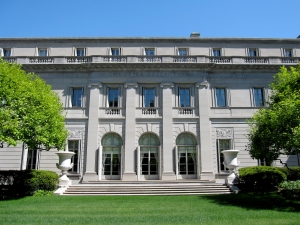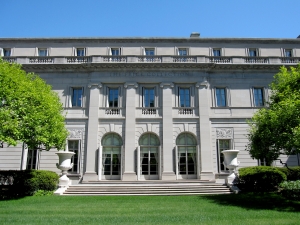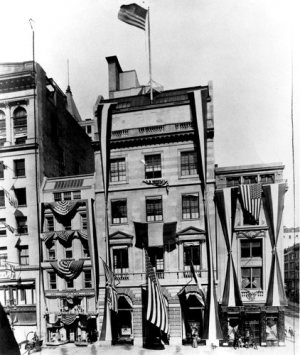|
Displaying items by tag: henry clay frick
Today, Margot Bogert, chair of the Frick Collection’s board of trustees, announced three new trustee-elects: banker Elizabeth “Betty” Eveillard, philanthropist Monika McLennan, and banker J. Fife Symington IV, who is a great-great-grandson of the Frick’s founder, Henry Clay Frick.
Bogert publicly welcomed the new board members in a statement:

When Henry Clay Frick set out to furnish his new residence at 1 East 70th Street, his intention was to replicate the grand houses of the greatest European collectors, who surrounded their Old Master paintings with exquisite furniture and decorative objects. With the assistance of the art dealer Sir Joseph Duveen, Frick quickly assembled an impressive collection of decorative arts, including vases, potpourris, jugs, and basins made at Sèvres, the preeminent eighteenth-century French porcelain manufactory. Many of these objects are featured in the upcoming exhibition "From Sèvres to Fifth Avenue," which presents a new perspective on the collection by exploring the role Sèvres porcelain played in eighteenth-century France, as well as during the American Gilded Age. While some of these striking objects are regularly displayed in the grand context of the Fragonard and Boucher Rooms, others have come out of a long period of storage for this presentation. These finely painted examples will be seen together in a new light in the Portico Gallery.

Since the mid-nineteenth century, Renaissance Italian bronze statuettes, maiolica wares, Limoges enamels, and French sixteenth-century ceramics belonged to the category of objects that every serious art collector in Europe hoped to own, their value and association with royal and noble provenance bestowing upon their owners an aura of cultivation and taste. The greatest collections were assembled by Sir Richard Wallace, George Salting, Frederic Spitzer, and several members of the Rothschild family, among others. Henry Clay Frick, who emulated these European collectors, acquired in 1915 most of John Pierpont Morgan’s renowned collection of Italian bronzes and Limoges enamels. Three years later, he completed his Renaissance collection of sculpture and decorative arts with the acquisition of a Saint-Porchaire ewer, shown at right, related to a small group of elaborate French sixteenth-century ceramics. Only about seventy authentic pieces of Saint-Porchaire are known today, making them exceedingly rare. In March, with the generous support of Trustee Sidney R. Knafel, the Frick purchased an unusual Saint-Porchaire ewer decorated with a lizard spout and a handle in the shape of a bearded man.
Over 30 masterpieces from the celebrated Frick Collection will be seen outside New York for the first time as part of a special exhibition at the Mauritshuis in The Hague in 2015.
"The Frick Collection – Art Treasures from New York" will be the first major exhibition to be displayed in the new wing of the Mauritshuis following the opening exhibition of the museum in 2014. The exhibition will give visitors to the Mauritshuis a fascinating insight into the history of The Frick Collection and its founder, wealthy American steel magnate Henry Clay Frick (1849—1919). The works selected for the exhibition are masterpieces from the 13th to 19th centuries, which include not only paintings, but also drawings, sculpture and decorative arts, reflecting the outstanding quality and diversity of The Frick Collection. They perfectly complement the Mauritshuis’s own collection which focuses on Dutch art of the Golden Age.
The Frick Collection has always been rich in Spanish paintings, particularly works by Velázquez, El Greco and Goya. The museum’s founder, Henry Clay Frick, bought three canvases by El Greco on his travels to Spain, and they currently hang together as part of “El Greco in New York,” an exhibition organized in collaboration with the Frick, the Metropolitan Museum of Art and the Hispanic Society to commemorate the 400th anniversary of the artist’s death.
But in 1904, before Frick acquired any of these well-known paintings, he bought a self-portrait by the 17th-century Baroque artist Bartolomé Esteban Murillo.

El Greco’s Vincenzo Anastagi, acquired a century ago by Henry Clay Frick, is one of The Frick Collection’s most celebrated paintings and one of only two full-length portraits by the master. It was executed during the artist’s six-year stay in Rome, before he moved to Spain, where he spent the rest of his career. Much of the force of this work emanates from the resplendent half-armor worn by Anastagi. Rich highlights applied with broad brushstrokes accentuate the steel, its metallic sheen contrasting with the velvety texture of Anastagi’s green breeches and the dark crimson curtain. To mark the 400th anniversary of El Greco’s death, the Frick will pair Vincenzo Anastagi with the rarely seen Jacopo Boncompagni by the artist’s Roman contemporary Scipione Pulzone. With its gleaming, highly detailed polish, Pulzone’s portrait of Boncompagni, on loan from a private collection, epitomizes the elegant style that dominated high-society portraiture in Rome during the last quarter of the sixteenth century. El Greco’s painterly portrayal of Anastagi stands in stark contrast, underscoring the artist’s innovative departures from convention. The exhibition, held in the Frick’s East Gallery, is organized by Jeongho Park, Anne L. Poulet Curatorial Fellow. It is generously funded by gifts from The Andrew W. Mellon Foundation and Sidney R. Knafel and Londa Weisman in memory of Vera and Walter A. Eberstadt. The Frick will continue its celebration of El Greco this autumn and winter with a collaboration with The Metropolitan Museum of Art.
When architect Jon Traficonte arrived at the Frick Art & Historical Center for the first time, he wasn't quite sure where to go.
Like a lot of first time visitors, he couldn't see the entrance to the art museum and didn't know where to check in for a tour of Clayton or how to locate the Henry Clay Frick family's former home.
Many guests toured the house or museum without being aware of the Car and Carriage Museum, the Frick Cafe or the greenhouse on the property.

Next year, the Frick Collection in New York will loan a significant group of paintings, sculptures and decorative objects to the Mauritshuis in The Hague. It will be the first time that the Frick has lent such a substantial portion of its collection to a fellow institution. The Frick recently welcomed a number of masterpieces from the Mauritshuis, including Johannes Vermeer’s ‘Girl with a Pearl Earring,’ that were presented in the exhibition ‘Masterpieces of Dutch Painting from the Mauritshuis,’ which attracted record crowds.
‘A Country House in New York: Highlights From the Frick Collection’ will present works acquired by the museum after founder Henry Clay Frick’s death in 1919. In his will, Frick stated that none of the artworks that he acquired, which make up about two-thirds of the Frick Collection, can be lent to another institution. The exhibition will include works by Jan van Eyck, Thomas Gainsborough, John Constable and Jean-Auguste-Dominique Ingres. ‘A Country House in New York’ will remain on view through May 10, 2015.
On June 27, 2014, the Mauritshuis will reopen following a two-year renovation and expansion.

165 years ago, the Knoedler Gallery opened its doors in New York and went on to help create some of the country’s most celebrated collections including those of Paul Mellon, Henry Clay Frick, and Robert Sterling Clark. Throughout the years, top-notch works by artists such as van Gogh, Manet, Winslow Homer, John Singer Sargent, Louise Bourgeois, and Willem de Kooning passed through the gallery. When the Soviet government sold hundreds of paintings from the State Hermitage Museum in Leningrad in the 1930s, they chose to work with Knoedler to sell paintings by masters like Rembrandt, Raphael, and Velazquez.
Knoedler’s exemplary past is often forgotten as the gallery’s present has been mired in lawsuits and accusations that the company’s former president, Ann Freedman, was in the business of selling fakes. Last year, Knoedler Gallery closed its doors for good.
This week, Los Angeles’ Getty Research Institute announced that it had bought the Knoedler Gallery archive. Spanning from around 1850 to 1971, the archive includes stock books, sales books, a photo archive and files of correspondence, including letters from artists and collectors, some with illustrations. The Getty was interested in Knoedler’s archive because it offers an expansive glimpse into the history of collecting and the art market in the United States and Europe from the mid-19th century to modern times.
The archive was purchased from Knoedler’s owner, Michael Hammer, for an undisclosed amount. Meticulously preserved, the archive will be available to scholars and digitized for online research after the Getty catalogues and conserves it all.
|
|
|
|
|